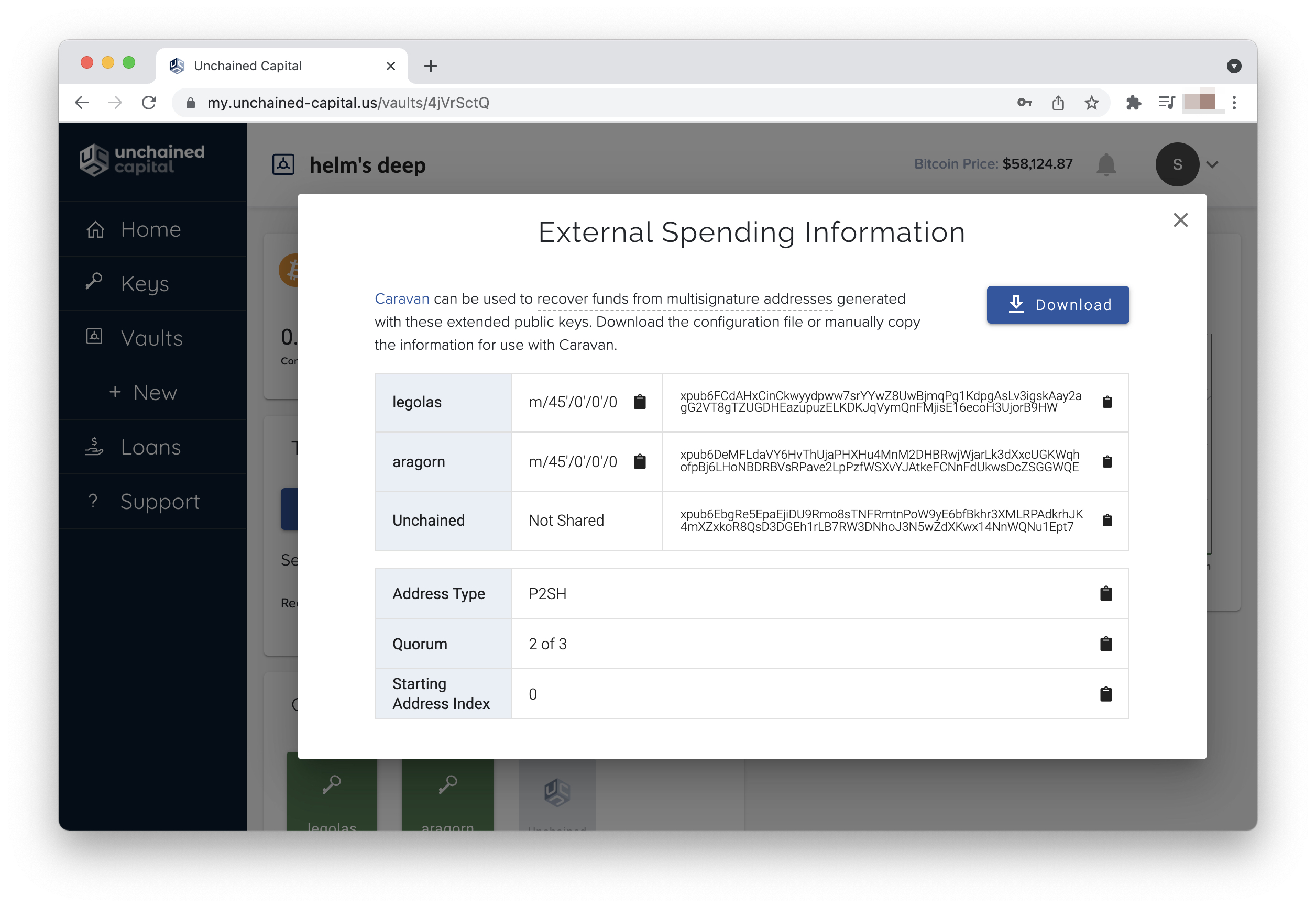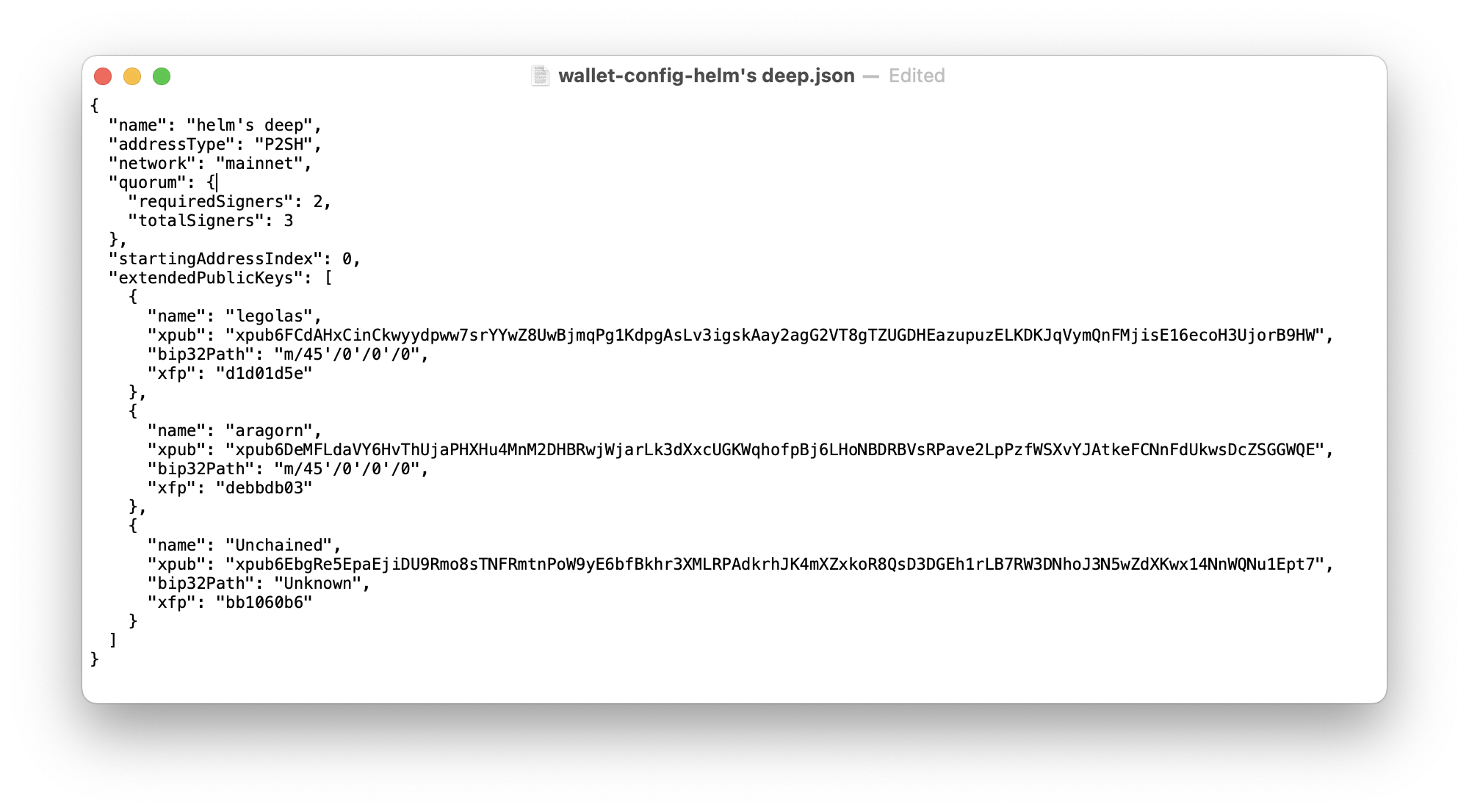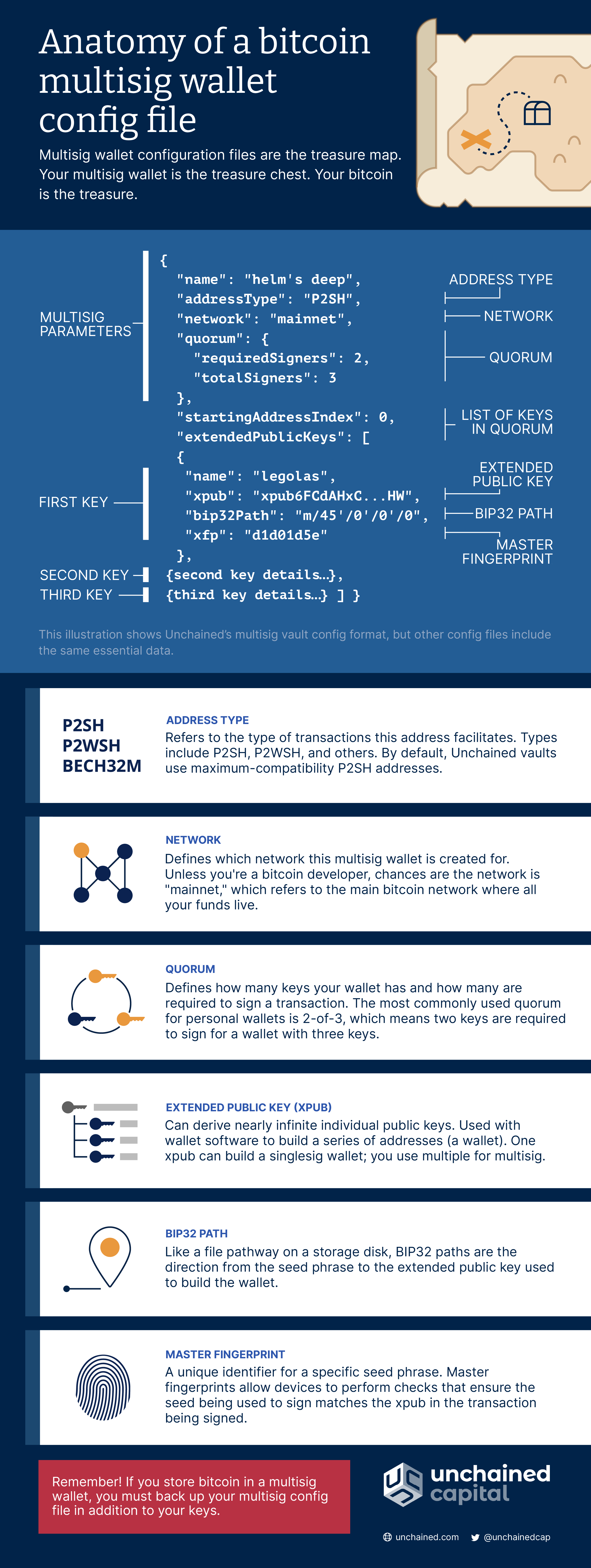How does the bitcoin source code define its 21 million cap?
Many of bitcoin’s staunchest critics have expressed doubt about its 21 million cap, but perhaps the most mindless criticism relates…
,
If you use bitcoin multisig, whether that be through Caravan, Sparrow, Electrum, or an Unchained vault, you should know about something called a multisig wallet configuration file. This file contains key details that describe how the wallet was constructed. In other words, it contains information that tells your wallet software how to find your multisignature addresses.
You can think of the wallet configuration file like a treasure map. It contains the directions from your seed to your private and public keys, as well as basic information about your multisig setup like the address type, network, and quorum. Your multisig wallet, to extend the metaphor, is the treasure chest where your bitcoin live. Your bitcoin are the treasure.
If you’ve built your own Unchained vault or walked through our Concierge Onboarding, you know that a multisig wallet involves multiple bitcoin keys that can be combined to construct a single wallet. Wallet configuration files are specific to multisig bitcoin wallets, so if you haven’t yet created an Unchained vault or a multisig wallet through another application, you probably don’t have one.
Why is this wallet configuration file important for you to know about? At Unchained, we care about eliminating single points of failure when it comes to your wealth. With a standard singlesig wallet, you only need to back up your key, but with multisig you need your keys and your config file. This ensures that if the software you’re using for multisig isn’t accessible, you can use the configuration file along with your keys to create, sign, and broadcast a bitcoin transaction using another tool!
You should also know that wallet configuration files are not all identical—although they do tend to contain the same basic information. In other words, they’re all treasure maps, but there are different kinds of treasure maps! While we can’t speak to how to find your wallet configuration details for every multisig wallet out there, we can tell you how to find it in your Unchained account.
To find and download your wallet configuration file in Unchained dashboard, simply log in to your account, click Vaults, click the name of the vault for which you want to download the file, click the three dots next to transact, click External Spend Info, and click Show Information. From there, you can Download the wallet configuration file to your device.

Let’s take a look at the wallet configuration file itself. If you open it up in a text editor on your computer, it should look like the screenshot below. This might look like a confusing mess at first, but let’s break it down so you can get a basic understanding of how it works.
There are two main sections to this file:
We’re going to take a look at these six topics below.

The first section to know about is addressType, which as its name implies refers to the type of transactions this address facilitates. Bitcoin address types include P2PKH, P2SH, P2WSH, Bech32, and Bech32m. By default, Unchained vaults use maximum-compatibility P2SH addresses.
If you’re using our multisig coordinator, Caravan, you’ll find that it offers options for P2SH or P2WSH, so you can create an address that uses SegWit. If you decide to use Caravan to recover your Unchained vault, you’ll need to use P2SH (or import a wallet config file, which selects this for you).
This section of your wallet config file defines which network this multisig wallet was created for. Unless you’re a bitcoin developer, chances are the network listed here is mainnet. This just tells you that the wallet was made for the main bitcoin network (as opposed to a bitcoin testnet that uses valueless funds for research and development purposes).
The quorum defines the number of keys in this multisig setup and how many are required to sign a transaction. The most commonly used quorum in bitcoin multisig is 2-of-3, which is what Unchained vaults use by default. A quorum of 2-of-3 means that two keys are required to sign for a wallet with three keys. As you can see in the screenshot above, this wallet is configured with 2 requiredSigners and 3 totalSigners, making this a 2-of-3 wallet.
All three keys in the quorum have an extended public key. If you have an Unchained vault, this is the key that you uploaded from your hardware device when you set up your keys in the Unchained dashboard. An xpub can derive nearly infinite individual public keys, and by extension are used with wallet software to build a series of addresses (a wallet). One xpub can build a singlesig wallet, but you need more than one for a multisig wallet.
Also commonly referred to as an address path or derivation path. The best way to understand a BIP32 path is like a file pathway on a storage disk for an old Windows machine. Just as a file is stored at C://Folder/Folder/File, BIP32 paths are the direction from the seed phrase to the extended public key used to build the wallet.
Master fingerprint is the least important concept to understand, but it’s part of the multisig wallet configuration file nonetheless. It is a unique identifier for a specific seed phrase. Extended fingerprints allow devices to perform checks that ensure the seed being used to sign matches the xpub in the transaction being signed.
 Protecting multisig config files and next steps
Protecting multisig config files and next stepsIt’s nice to know what information your wallet configuration file contains, but the most important thing for you to remember as a bitcoin multisig user—or Unchained vault client—is that you should keep this file in a safe place. In the very unlikely case that Unchained ceases to exist or our website goes down for an extended period of time, you can use this file to access and send your bitcoin to a new address.
If someone gets access to your config file, they will not be able to use it to steal your funds, but it will reveal private information about your bitcoin balances and transaction history. For this reason, we recommend storing your config file in a password manager like 1Password or LastPass.
To get the most out of Unchained and all of our products, and to learn more, be sure to subscribe to our channel on YouTube for regular educational information and Twitter for all the latest information about our products and services.
Many of bitcoin’s staunchest critics have expressed doubt about its 21 million cap, but perhaps the most mindless criticism relates…
Ted Stevenot, Stephen HallWhen Satoshi Nakamoto created bitcoin, he established in its code a fixed number of bitcoin that will ever exist. Since…
Ted StevenotOriginally published in Parker’s dedicated Gradually, Then Suddenly publication. Bitcoin is often described as a hedge, or more specifically, a…
Parker Lewis